BUS708 Statistical Analysis: Factors Determining Tax Lodgement
VerifiedAdded on 2023/06/15
|9
|2112
|397
Report
AI Summary
This report investigates the factors that determine the lodging method of tax returns in Australia, utilizing data from the Australian Taxation Office (ATO). The analysis explores the proportion of taxpayers using tax agents, the relationship between age groups and lodgement methods, the connection between total income and lodgement method, and the correlation between total income and deduction amounts. Key findings indicate a relationship between lodgement method and age, with younger individuals preferring self-lodgement and older individuals favoring tax agents. The study also reveals that higher-income earners tend to use agents, while lower-income earners often prepare their tax returns personally. Furthermore, the report highlights a positive correlation between income level and deductions. The report concludes by suggesting further research to understand the reasons behind taxpayers' choices of lodgement methods.
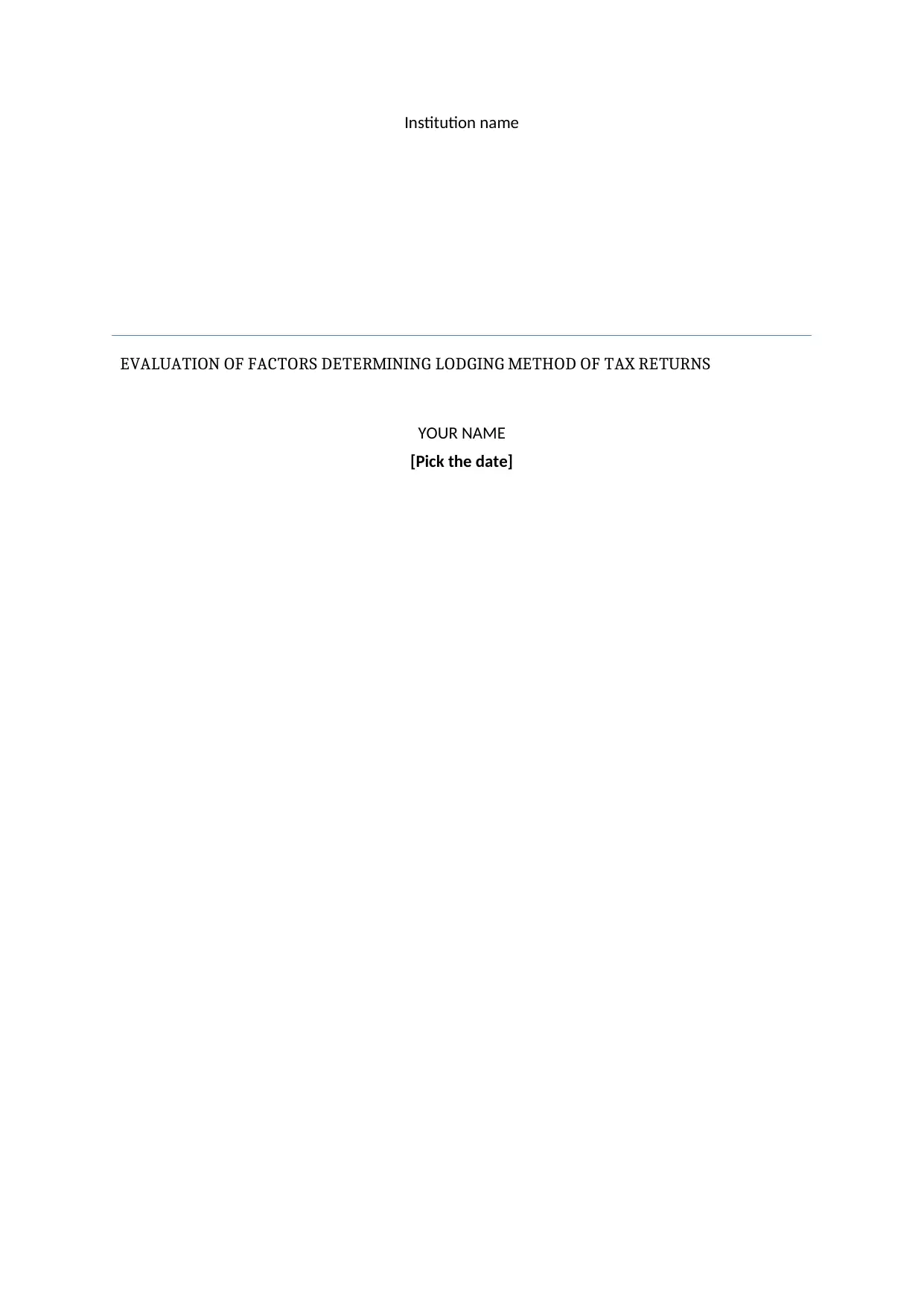
Institution name
EVALUATION OF FACTORS DETERMINING LODGING METHOD OF TAX RETURNS
YOUR NAME
[Pick the date]
EVALUATION OF FACTORS DETERMINING LODGING METHOD OF TAX RETURNS
YOUR NAME
[Pick the date]
Paraphrase This Document
Need a fresh take? Get an instant paraphrase of this document with our AI Paraphraser
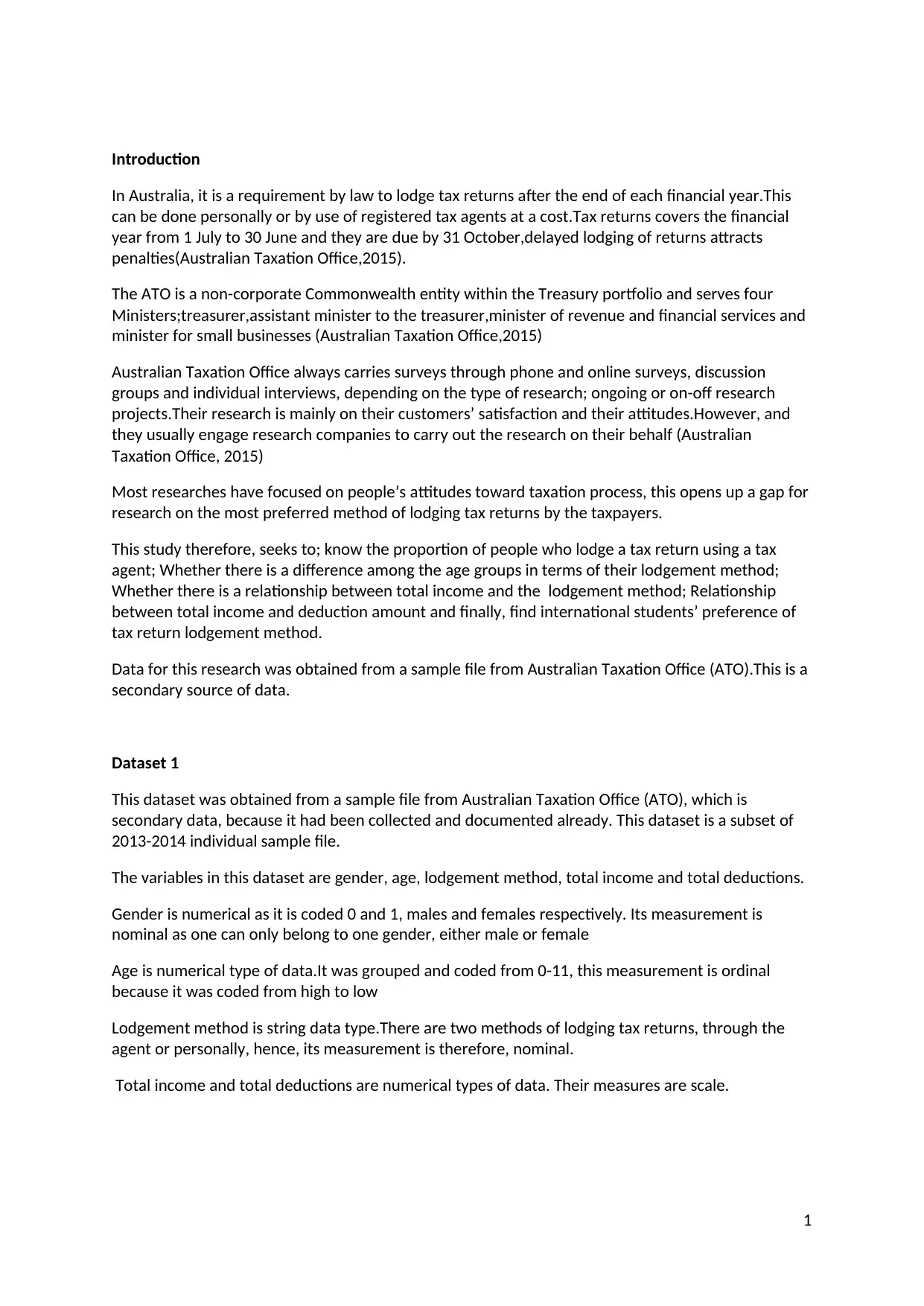
Introduction
In Australia, it is a requirement by law to lodge tax returns after the end of each financial year.This
can be done personally or by use of registered tax agents at a cost.Tax returns covers the financial
year from 1 July to 30 June and they are due by 31 October,delayed lodging of returns attracts
penalties(Australian Taxation Office,2015).
The ATO is a non-corporate Commonwealth entity within the Treasury portfolio and serves four
Ministers;treasurer,assistant minister to the treasurer,minister of revenue and financial services and
minister for small businesses (Australian Taxation Office,2015)
Australian Taxation Office always carries surveys through phone and online surveys, discussion
groups and individual interviews, depending on the type of research; ongoing or on-off research
projects.Their research is mainly on their customers’ satisfaction and their attitudes.However, and
they usually engage research companies to carry out the research on their behalf (Australian
Taxation Office, 2015)
Most researches have focused on people’s attitudes toward taxation process, this opens up a gap for
research on the most preferred method of lodging tax returns by the taxpayers.
This study therefore, seeks to; know the proportion of people who lodge a tax return using a tax
agent; Whether there is a difference among the age groups in terms of their lodgement method;
Whether there is a relationship between total income and the lodgement method; Relationship
between total income and deduction amount and finally, find international students’ preference of
tax return lodgement method.
Data for this research was obtained from a sample file from Australian Taxation Office (ATO).This is a
secondary source of data.
Dataset 1
This dataset was obtained from a sample file from Australian Taxation Office (ATO), which is
secondary data, because it had been collected and documented already. This dataset is a subset of
2013-2014 individual sample file.
The variables in this dataset are gender, age, lodgement method, total income and total deductions.
Gender is numerical as it is coded 0 and 1, males and females respectively. Its measurement is
nominal as one can only belong to one gender, either male or female
Age is numerical type of data.It was grouped and coded from 0-11, this measurement is ordinal
because it was coded from high to low
Lodgement method is string data type.There are two methods of lodging tax returns, through the
agent or personally, hence, its measurement is therefore, nominal.
Total income and total deductions are numerical types of data. Their measures are scale.
1
In Australia, it is a requirement by law to lodge tax returns after the end of each financial year.This
can be done personally or by use of registered tax agents at a cost.Tax returns covers the financial
year from 1 July to 30 June and they are due by 31 October,delayed lodging of returns attracts
penalties(Australian Taxation Office,2015).
The ATO is a non-corporate Commonwealth entity within the Treasury portfolio and serves four
Ministers;treasurer,assistant minister to the treasurer,minister of revenue and financial services and
minister for small businesses (Australian Taxation Office,2015)
Australian Taxation Office always carries surveys through phone and online surveys, discussion
groups and individual interviews, depending on the type of research; ongoing or on-off research
projects.Their research is mainly on their customers’ satisfaction and their attitudes.However, and
they usually engage research companies to carry out the research on their behalf (Australian
Taxation Office, 2015)
Most researches have focused on people’s attitudes toward taxation process, this opens up a gap for
research on the most preferred method of lodging tax returns by the taxpayers.
This study therefore, seeks to; know the proportion of people who lodge a tax return using a tax
agent; Whether there is a difference among the age groups in terms of their lodgement method;
Whether there is a relationship between total income and the lodgement method; Relationship
between total income and deduction amount and finally, find international students’ preference of
tax return lodgement method.
Data for this research was obtained from a sample file from Australian Taxation Office (ATO).This is a
secondary source of data.
Dataset 1
This dataset was obtained from a sample file from Australian Taxation Office (ATO), which is
secondary data, because it had been collected and documented already. This dataset is a subset of
2013-2014 individual sample file.
The variables in this dataset are gender, age, lodgement method, total income and total deductions.
Gender is numerical as it is coded 0 and 1, males and females respectively. Its measurement is
nominal as one can only belong to one gender, either male or female
Age is numerical type of data.It was grouped and coded from 0-11, this measurement is ordinal
because it was coded from high to low
Lodgement method is string data type.There are two methods of lodging tax returns, through the
agent or personally, hence, its measurement is therefore, nominal.
Total income and total deductions are numerical types of data. Their measures are scale.
1

Display of the first five cases of the dataset 1.
Table 1
Dataset 2.
The data will be collected through face-to-face interviews guided by structured questionnaires; the
data is unbiased, as simple random sampling will be utilized in selection of the sample.This means
that each student will have equal chance of being included in the sample.
This is a primary source of data.
The variables in the dataset include the gender, age, and education level and lodgement method. All
variables are numerical data type.
Descriptives
Gender and lodgement method
The bar chart below displays the count of each gender and the preferred method of lodging tax
returns.
The graph shows that use of agents is the most preferred method of lodging returns by both gender.
The proportion of males preferring use of agents (392/1000) is higher compared to the proportion of
the females (339/1000).More females prefer preparing for themselves (143) than males (126)
Figure 1
2
Table 1
Dataset 2.
The data will be collected through face-to-face interviews guided by structured questionnaires; the
data is unbiased, as simple random sampling will be utilized in selection of the sample.This means
that each student will have equal chance of being included in the sample.
This is a primary source of data.
The variables in the dataset include the gender, age, and education level and lodgement method. All
variables are numerical data type.
Descriptives
Gender and lodgement method
The bar chart below displays the count of each gender and the preferred method of lodging tax
returns.
The graph shows that use of agents is the most preferred method of lodging returns by both gender.
The proportion of males preferring use of agents (392/1000) is higher compared to the proportion of
the females (339/1000).More females prefer preparing for themselves (143) than males (126)
Figure 1
2
⊘ This is a preview!⊘
Do you want full access?
Subscribe today to unlock all pages.

Trusted by 1+ million students worldwide
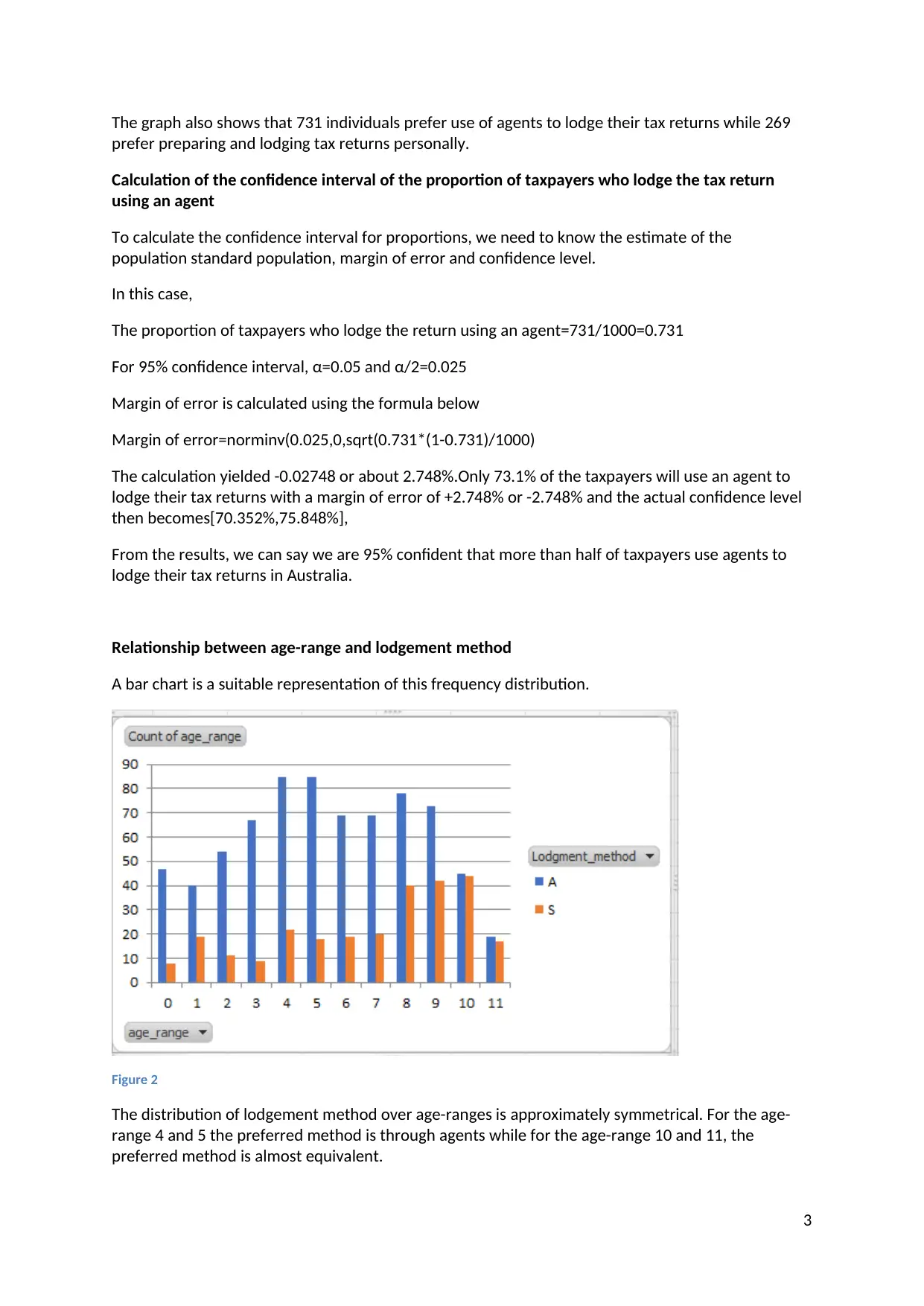
The graph also shows that 731 individuals prefer use of agents to lodge their tax returns while 269
prefer preparing and lodging tax returns personally.
Calculation of the confidence interval of the proportion of taxpayers who lodge the tax return
using an agent
To calculate the confidence interval for proportions, we need to know the estimate of the
population standard population, margin of error and confidence level.
In this case,
The proportion of taxpayers who lodge the return using an agent=731/1000=0.731
For 95% confidence interval, α=0.05 and α/2=0.025
Margin of error is calculated using the formula below
Margin of error=norminv(0.025,0,sqrt(0.731*(1-0.731)/1000)
The calculation yielded -0.02748 or about 2.748%.Only 73.1% of the taxpayers will use an agent to
lodge their tax returns with a margin of error of +2.748% or -2.748% and the actual confidence level
then becomes[70.352%,75.848%],
From the results, we can say we are 95% confident that more than half of taxpayers use agents to
lodge their tax returns in Australia.
Relationship between age-range and lodgement method
A bar chart is a suitable representation of this frequency distribution.
Figure 2
The distribution of lodgement method over age-ranges is approximately symmetrical. For the age-
range 4 and 5 the preferred method is through agents while for the age-range 10 and 11, the
preferred method is almost equivalent.
3
prefer preparing and lodging tax returns personally.
Calculation of the confidence interval of the proportion of taxpayers who lodge the tax return
using an agent
To calculate the confidence interval for proportions, we need to know the estimate of the
population standard population, margin of error and confidence level.
In this case,
The proportion of taxpayers who lodge the return using an agent=731/1000=0.731
For 95% confidence interval, α=0.05 and α/2=0.025
Margin of error is calculated using the formula below
Margin of error=norminv(0.025,0,sqrt(0.731*(1-0.731)/1000)
The calculation yielded -0.02748 or about 2.748%.Only 73.1% of the taxpayers will use an agent to
lodge their tax returns with a margin of error of +2.748% or -2.748% and the actual confidence level
then becomes[70.352%,75.848%],
From the results, we can say we are 95% confident that more than half of taxpayers use agents to
lodge their tax returns in Australia.
Relationship between age-range and lodgement method
A bar chart is a suitable representation of this frequency distribution.
Figure 2
The distribution of lodgement method over age-ranges is approximately symmetrical. For the age-
range 4 and 5 the preferred method is through agents while for the age-range 10 and 11, the
preferred method is almost equivalent.
3
Paraphrase This Document
Need a fresh take? Get an instant paraphrase of this document with our AI Paraphraser
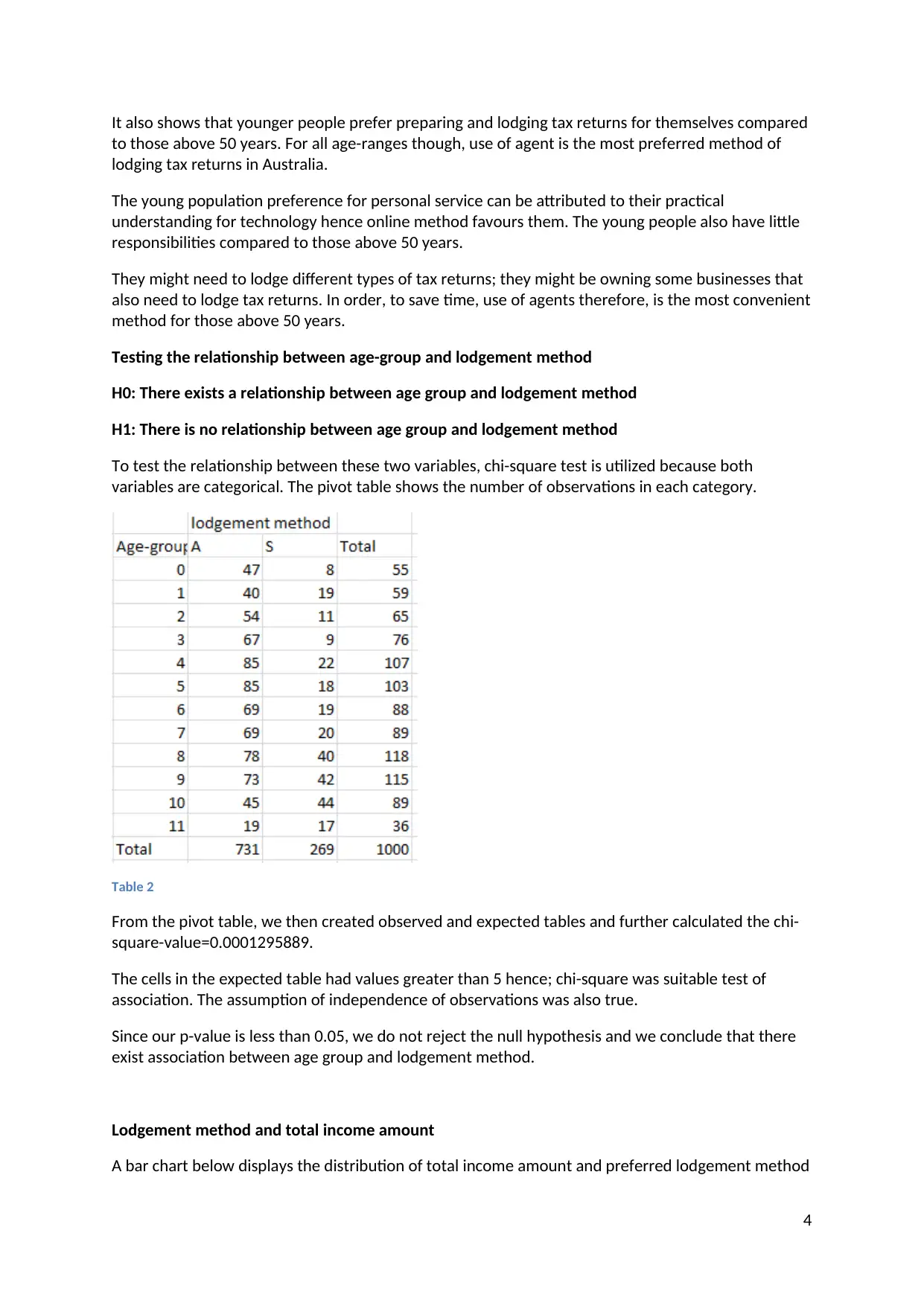
It also shows that younger people prefer preparing and lodging tax returns for themselves compared
to those above 50 years. For all age-ranges though, use of agent is the most preferred method of
lodging tax returns in Australia.
The young population preference for personal service can be attributed to their practical
understanding for technology hence online method favours them. The young people also have little
responsibilities compared to those above 50 years.
They might need to lodge different types of tax returns; they might be owning some businesses that
also need to lodge tax returns. In order, to save time, use of agents therefore, is the most convenient
method for those above 50 years.
Testing the relationship between age-group and lodgement method
H0: There exists a relationship between age group and lodgement method
H1: There is no relationship between age group and lodgement method
To test the relationship between these two variables, chi-square test is utilized because both
variables are categorical. The pivot table shows the number of observations in each category.
Table 2
From the pivot table, we then created observed and expected tables and further calculated the chi-
square-value=0.0001295889.
The cells in the expected table had values greater than 5 hence; chi-square was suitable test of
association. The assumption of independence of observations was also true.
Since our p-value is less than 0.05, we do not reject the null hypothesis and we conclude that there
exist association between age group and lodgement method.
Lodgement method and total income amount
A bar chart below displays the distribution of total income amount and preferred lodgement method
4
to those above 50 years. For all age-ranges though, use of agent is the most preferred method of
lodging tax returns in Australia.
The young population preference for personal service can be attributed to their practical
understanding for technology hence online method favours them. The young people also have little
responsibilities compared to those above 50 years.
They might need to lodge different types of tax returns; they might be owning some businesses that
also need to lodge tax returns. In order, to save time, use of agents therefore, is the most convenient
method for those above 50 years.
Testing the relationship between age-group and lodgement method
H0: There exists a relationship between age group and lodgement method
H1: There is no relationship between age group and lodgement method
To test the relationship between these two variables, chi-square test is utilized because both
variables are categorical. The pivot table shows the number of observations in each category.
Table 2
From the pivot table, we then created observed and expected tables and further calculated the chi-
square-value=0.0001295889.
The cells in the expected table had values greater than 5 hence; chi-square was suitable test of
association. The assumption of independence of observations was also true.
Since our p-value is less than 0.05, we do not reject the null hypothesis and we conclude that there
exist association between age group and lodgement method.
Lodgement method and total income amount
A bar chart below displays the distribution of total income amount and preferred lodgement method
4
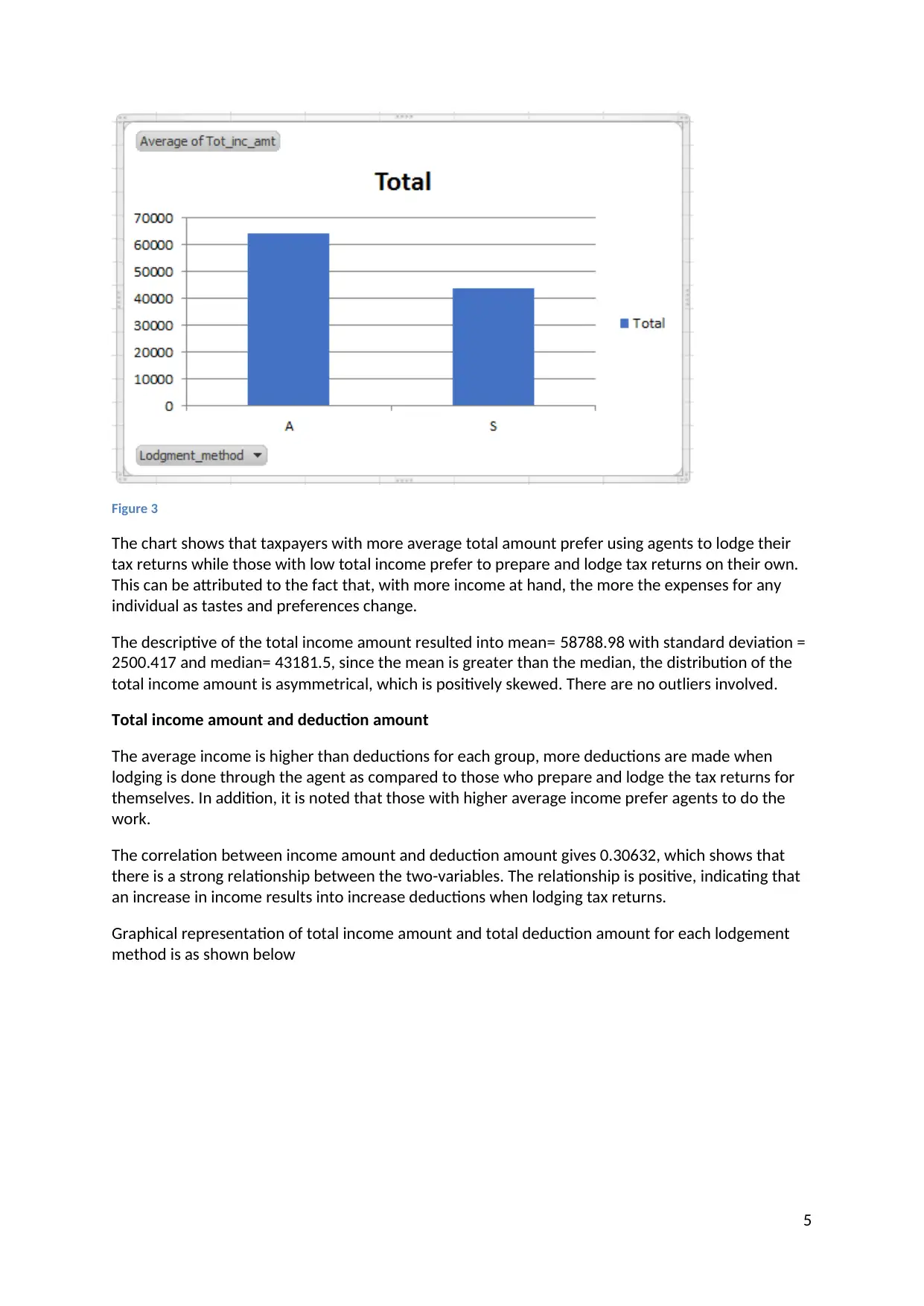
Figure 3
The chart shows that taxpayers with more average total amount prefer using agents to lodge their
tax returns while those with low total income prefer to prepare and lodge tax returns on their own.
This can be attributed to the fact that, with more income at hand, the more the expenses for any
individual as tastes and preferences change.
The descriptive of the total income amount resulted into mean= 58788.98 with standard deviation =
2500.417 and median= 43181.5, since the mean is greater than the median, the distribution of the
total income amount is asymmetrical, which is positively skewed. There are no outliers involved.
Total income amount and deduction amount
The average income is higher than deductions for each group, more deductions are made when
lodging is done through the agent as compared to those who prepare and lodge the tax returns for
themselves. In addition, it is noted that those with higher average income prefer agents to do the
work.
The correlation between income amount and deduction amount gives 0.30632, which shows that
there is a strong relationship between the two-variables. The relationship is positive, indicating that
an increase in income results into increase deductions when lodging tax returns.
Graphical representation of total income amount and total deduction amount for each lodgement
method is as shown below
5
The chart shows that taxpayers with more average total amount prefer using agents to lodge their
tax returns while those with low total income prefer to prepare and lodge tax returns on their own.
This can be attributed to the fact that, with more income at hand, the more the expenses for any
individual as tastes and preferences change.
The descriptive of the total income amount resulted into mean= 58788.98 with standard deviation =
2500.417 and median= 43181.5, since the mean is greater than the median, the distribution of the
total income amount is asymmetrical, which is positively skewed. There are no outliers involved.
Total income amount and deduction amount
The average income is higher than deductions for each group, more deductions are made when
lodging is done through the agent as compared to those who prepare and lodge the tax returns for
themselves. In addition, it is noted that those with higher average income prefer agents to do the
work.
The correlation between income amount and deduction amount gives 0.30632, which shows that
there is a strong relationship between the two-variables. The relationship is positive, indicating that
an increase in income results into increase deductions when lodging tax returns.
Graphical representation of total income amount and total deduction amount for each lodgement
method is as shown below
5
⊘ This is a preview!⊘
Do you want full access?
Subscribe today to unlock all pages.

Trusted by 1+ million students worldwide

Figure 4
Conclusions
From our analyses, we note that there exists a relationship between lodgement method and all
other variables under consideration. Younger people prefer doing it for themselves while older
people prefer use of agents.
Use of agents is the most used method across gender .The proportion of males preferring use of
agents(392) is higher for than for the females(339).More females prefer preparing for
themselves(143) than males (126).
Taxpayers with more average total amount prefer using agents to lodge their tax returns while those
with low total income prefer to prepare and lodge tax returns on their own. Also the higher the
income level, the higher the deductions for tax returns.
Further research should be carried out to understand people’s choice of lodgement method.
Reasons as to why many prefer use of agents to personal lodging of tax returns.
6
Conclusions
From our analyses, we note that there exists a relationship between lodgement method and all
other variables under consideration. Younger people prefer doing it for themselves while older
people prefer use of agents.
Use of agents is the most used method across gender .The proportion of males preferring use of
agents(392) is higher for than for the females(339).More females prefer preparing for
themselves(143) than males (126).
Taxpayers with more average total amount prefer using agents to lodge their tax returns while those
with low total income prefer to prepare and lodge tax returns on their own. Also the higher the
income level, the higher the deductions for tax returns.
Further research should be carried out to understand people’s choice of lodgement method.
Reasons as to why many prefer use of agents to personal lodging of tax returns.
6
Paraphrase This Document
Need a fresh take? Get an instant paraphrase of this document with our AI Paraphraser
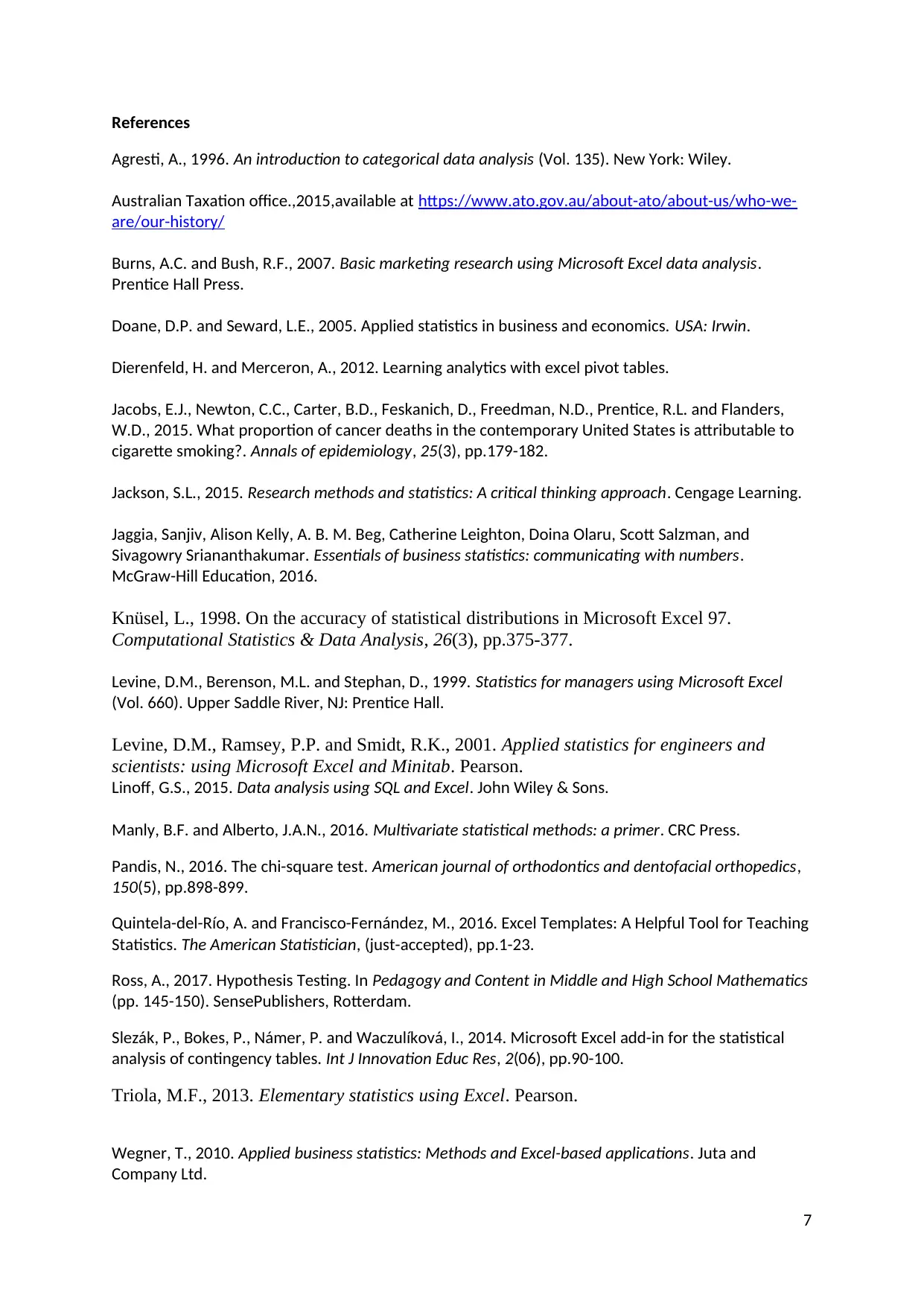
References
Agresti, A., 1996. An introduction to categorical data analysis (Vol. 135). New York: Wiley.
Australian Taxation office.,2015,available at https://www.ato.gov.au/about-ato/about-us/who-we-
are/our-history/
Burns, A.C. and Bush, R.F., 2007. Basic marketing research using Microsoft Excel data analysis.
Prentice Hall Press.
Doane, D.P. and Seward, L.E., 2005. Applied statistics in business and economics. USA: Irwin.
Dierenfeld, H. and Merceron, A., 2012. Learning analytics with excel pivot tables.
Jacobs, E.J., Newton, C.C., Carter, B.D., Feskanich, D., Freedman, N.D., Prentice, R.L. and Flanders,
W.D., 2015. What proportion of cancer deaths in the contemporary United States is attributable to
cigarette smoking?. Annals of epidemiology, 25(3), pp.179-182.
Jackson, S.L., 2015. Research methods and statistics: A critical thinking approach. Cengage Learning.
Jaggia, Sanjiv, Alison Kelly, A. B. M. Beg, Catherine Leighton, Doina Olaru, Scott Salzman, and
Sivagowry Sriananthakumar. Essentials of business statistics: communicating with numbers.
McGraw-Hill Education, 2016.
Knüsel, L., 1998. On the accuracy of statistical distributions in Microsoft Excel 97.
Computational Statistics & Data Analysis, 26(3), pp.375-377.
Levine, D.M., Berenson, M.L. and Stephan, D., 1999. Statistics for managers using Microsoft Excel
(Vol. 660). Upper Saddle River, NJ: Prentice Hall.
Levine, D.M., Ramsey, P.P. and Smidt, R.K., 2001. Applied statistics for engineers and
scientists: using Microsoft Excel and Minitab. Pearson.
Linoff, G.S., 2015. Data analysis using SQL and Excel. John Wiley & Sons.
Manly, B.F. and Alberto, J.A.N., 2016. Multivariate statistical methods: a primer. CRC Press.
Pandis, N., 2016. The chi-square test. American journal of orthodontics and dentofacial orthopedics,
150(5), pp.898-899.
Quintela-del-Río, A. and Francisco-Fernández, M., 2016. Excel Templates: A Helpful Tool for Teaching
Statistics. The American Statistician, (just-accepted), pp.1-23.
Ross, A., 2017. Hypothesis Testing. In Pedagogy and Content in Middle and High School Mathematics
(pp. 145-150). SensePublishers, Rotterdam.
Slezák, P., Bokes, P., Námer, P. and Waczulíková, I., 2014. Microsoft Excel add-in for the statistical
analysis of contingency tables. Int J Innovation Educ Res, 2(06), pp.90-100.
Triola, M.F., 2013. Elementary statistics using Excel. Pearson.
Wegner, T., 2010. Applied business statistics: Methods and Excel-based applications. Juta and
Company Ltd.
7
Agresti, A., 1996. An introduction to categorical data analysis (Vol. 135). New York: Wiley.
Australian Taxation office.,2015,available at https://www.ato.gov.au/about-ato/about-us/who-we-
are/our-history/
Burns, A.C. and Bush, R.F., 2007. Basic marketing research using Microsoft Excel data analysis.
Prentice Hall Press.
Doane, D.P. and Seward, L.E., 2005. Applied statistics in business and economics. USA: Irwin.
Dierenfeld, H. and Merceron, A., 2012. Learning analytics with excel pivot tables.
Jacobs, E.J., Newton, C.C., Carter, B.D., Feskanich, D., Freedman, N.D., Prentice, R.L. and Flanders,
W.D., 2015. What proportion of cancer deaths in the contemporary United States is attributable to
cigarette smoking?. Annals of epidemiology, 25(3), pp.179-182.
Jackson, S.L., 2015. Research methods and statistics: A critical thinking approach. Cengage Learning.
Jaggia, Sanjiv, Alison Kelly, A. B. M. Beg, Catherine Leighton, Doina Olaru, Scott Salzman, and
Sivagowry Sriananthakumar. Essentials of business statistics: communicating with numbers.
McGraw-Hill Education, 2016.
Knüsel, L., 1998. On the accuracy of statistical distributions in Microsoft Excel 97.
Computational Statistics & Data Analysis, 26(3), pp.375-377.
Levine, D.M., Berenson, M.L. and Stephan, D., 1999. Statistics for managers using Microsoft Excel
(Vol. 660). Upper Saddle River, NJ: Prentice Hall.
Levine, D.M., Ramsey, P.P. and Smidt, R.K., 2001. Applied statistics for engineers and
scientists: using Microsoft Excel and Minitab. Pearson.
Linoff, G.S., 2015. Data analysis using SQL and Excel. John Wiley & Sons.
Manly, B.F. and Alberto, J.A.N., 2016. Multivariate statistical methods: a primer. CRC Press.
Pandis, N., 2016. The chi-square test. American journal of orthodontics and dentofacial orthopedics,
150(5), pp.898-899.
Quintela-del-Río, A. and Francisco-Fernández, M., 2016. Excel Templates: A Helpful Tool for Teaching
Statistics. The American Statistician, (just-accepted), pp.1-23.
Ross, A., 2017. Hypothesis Testing. In Pedagogy and Content in Middle and High School Mathematics
(pp. 145-150). SensePublishers, Rotterdam.
Slezák, P., Bokes, P., Námer, P. and Waczulíková, I., 2014. Microsoft Excel add-in for the statistical
analysis of contingency tables. Int J Innovation Educ Res, 2(06), pp.90-100.
Triola, M.F., 2013. Elementary statistics using Excel. Pearson.
Wegner, T., 2010. Applied business statistics: Methods and Excel-based applications. Juta and
Company Ltd.
7

8
⊘ This is a preview!⊘
Do you want full access?
Subscribe today to unlock all pages.

Trusted by 1+ million students worldwide
1 out of 9
Related Documents
Your All-in-One AI-Powered Toolkit for Academic Success.
+13062052269
info@desklib.com
Available 24*7 on WhatsApp / Email
![[object Object]](/_next/static/media/star-bottom.7253800d.svg)
Unlock your academic potential
Copyright © 2020–2025 A2Z Services. All Rights Reserved. Developed and managed by ZUCOL.





